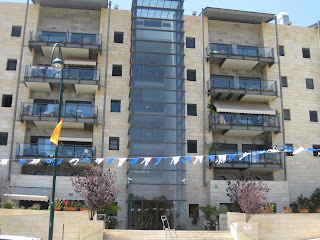Recently, standard recycling bins for bottles in my residential town have been replaced with huge, red plastic bins in strawberry format. The 'strawberry' has two round black 'eyes' through which bottles are introduced into the red container, and a black slot through which nylon/plastic bags are slipped into it. The stuff is taken out through the bottom part which has a square door opening.

round black hole for bottles

slot (rubber black tabs covering it)
The red containers , placed in 'strategic' public places such as at a main street corner, near a supermarket, restaurant, park , bus stop, parking area - seem to be highly durable and color-fading resistant; The intention and idea are good; the design is, however, not very attractive, in my opinion. It looks huge , awkward, and far from resembling a natural strawberry. I hope it's experimental and the people responsible for the project, will either improve the look of the strawberry or improve the former facility. In most places, by the way, the bottle recycling bin is placed close to the paper recycling bin, and/or the trash bin. Good neighbors.

near building with gym studio & supermarket

adjacent to paper recycling bin
former bottle recycling facility
Why strawberry? Well, our town was in its beginning, a rural settlement surrounded by strawberry fields . It still has some of the fields , and its informal icon is the strawberry. Along the pedestrian part of the avenues that run to and from the municipality building, there are many plastic strawberry exhibits in various colors created by local artists. These 'strawberries' display all sorts of prints and inscriptions such as "only love brings love". Perhaps the love slogan is correct , but all this affluence of plastic strawberry exhibits might gradually 'kill' the desire for the real fruit.

'strawberry' with Love slogan (in hebrew) at top





















































